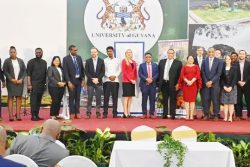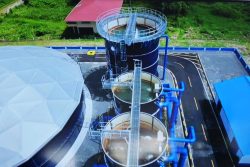Rice farmers from Regions Two, Three, Five and Six met Agriculture Minister Zulfikar Mustapha on Wednesday to discuss the problems they were facing in the industry. A press release from the Ministry said that they wanted the government to intervene over what they regarded as price gouging by spare parts dealers, although it was recognised that most of their problems were a consequence of unfavourable weather conditions and external economic factors. They also asked for an across-the-board price for paddy, since farmers in all regions had to face the same issues. Where this was concerned Mr Mustapha explained to them that it would not be possible to standardise the price of paddy, because the transportation costs for millers varied from region to region. The cost in Region Two, for example, would be more than that in Region Five, although he assured them the government would continue to engage millers on prices. In addition, he said, it was still in contact with Panama in an attempt to recover the payments that country owed to millers here.
In relation to the price gouging allegation, the release reported the Minister as reminding the farmers that VAT was no longer applicable to inputs and equipment for the agricultural sector but said he would engage the Guyana Revenue Authority on the issue after he was informed that some dealers were still charging VAT. That apart, he also told them that the government was in discussion to source cheaper fertilizers. He was then quoted as saying: “Most of the issues faced in the sector, we have to work together to resolve them. The weather hasn’t been favourable but we are working to strengthen our infrastructure. We are building new pump stations to assist with drainage. We are building new farm-to-market roads, and rehabilitating dams so that you can access your fields. We’ve been working to enhance the drying facilities that we have across the country …”
The Ministry of Agriculture does not have it in its direct power to confront dishonest parts dealers, force irresponsible Panamanians to pay the millers, or stop the Ukraine War which has caused high fertiliser prices, but it does have an obligation to advise farmers about the problem which affects them most, i.e, climate change. Mr Mustapha spoke about strengthening the infrastructure and building new pump stations to help with drainage as well as rehabilitating dams, and while all these initiatives are vital, at best they address the fundamental problem only obliquely.
At the end of last month we reported on rice cultivation in Leguan where lands have been abandoned by farmers for the last three or four crop cycles because of changing weather patterns. This has caused them substantial losses and has left several in debt. A few have decided to change from rice to cattle rearing, while others have tried growing bananas along with rice to limit their losses. Bananas are a crop which can withstand the heavy, recurrent rainfall. One source told our reporter that fewer farmers had returned to cultivate this year, and that only about one third of the lands have been cultivated. Last year the newspaper was told, there were about $20 million in losses on an island where rice provides the main source of income for residents.
As was pointed out, it is not as if the situation on Leguan is unique; the changing weather pattern affected the whole of the Essequibo coast as well as Berbice. With reference to the last-named county President of the Guyana Rice Producers Association Lekha Rambrich told this newspaper that the rainfall had prevented many farmers from being able to prepare their lands in time for cultivation. He was quoted as saying, “The lands become so saturated you cannot go into reap nor [can] you … go into preparing it … We have seen rain falling in April and October when normally it just drizzles, but these past years it has been continuous.” From a total of 235,000 acres under rice only 180,000 were being cultivated for this crop. Low production also affects the millers, since they are unable to sign new contracts to maintain a hold on their markets or go after new ones.
We reported that in a context of such major losses, questions were being raised as to whether it is not time for a rice fund to be established in order to support the industry, although Mr Rambrich indicated there might be technical issues in the way of this. For his part Minister Mustapha said that although there was no fund in place to support farmers who were suffering as a result of climate change, the Guyana Rice Development Board would help farmers through measures other than cash handouts. Even if a fund were set up for rice farmers, it would be an interim measure. In the longer term the government has to address the implications of climate change and advise the farmers accordingly. And it is not just the rice farmers. The majority of Guyana’s inhabitants live on the coast, and Georgetown, New Amsterdam and their environs aside, a large proportion of them are engaged in agriculture of one kind or another. What does the future of the coast look like, and more particularly, what is the future of the crops which are grown there, particularly rice, and, it might be added, sugar too? Our report mentioned some varieties of rice such as the GRDB15 and 196 which can withstand the impact of the change in climate, but that the farmers preferred varieties which produced higher yields such as the GRDB 16 and 10.
It is time that the Ministry of Agriculture started looking at these matters and helping the farmers to transition to varieties which are resistant to the changing weather conditions, as well as looking at the kind of infrastructure suitable for each of the regions which will be required for them to be able to cultivate the land. If it is not possible for the farmers to adjust and the government to provide the necessary infrastructure some of which the Minister listed, then it would have to be asked whether rice would still be a viable crop in the long term. According to forecasts this crop season is expected to be dry, and therefore will allow the farmers to prepare land for the next crop. That, however, will just be an interlude; it does not reflect the longer trend of what will happen along the coast in terms of weather patterns.







